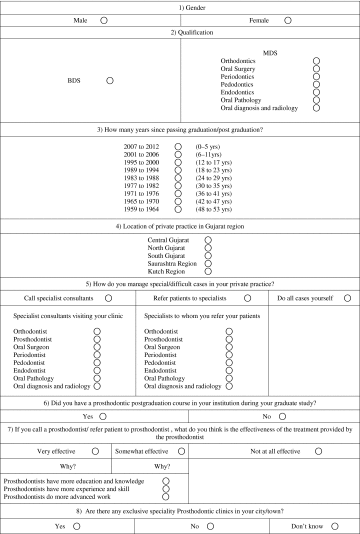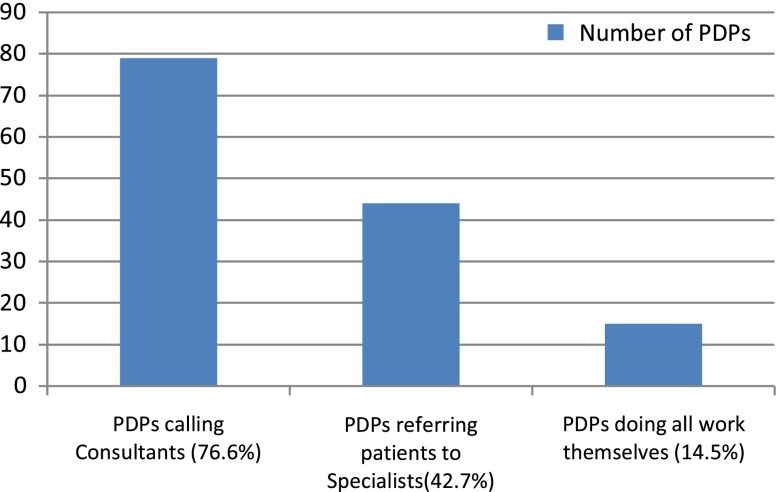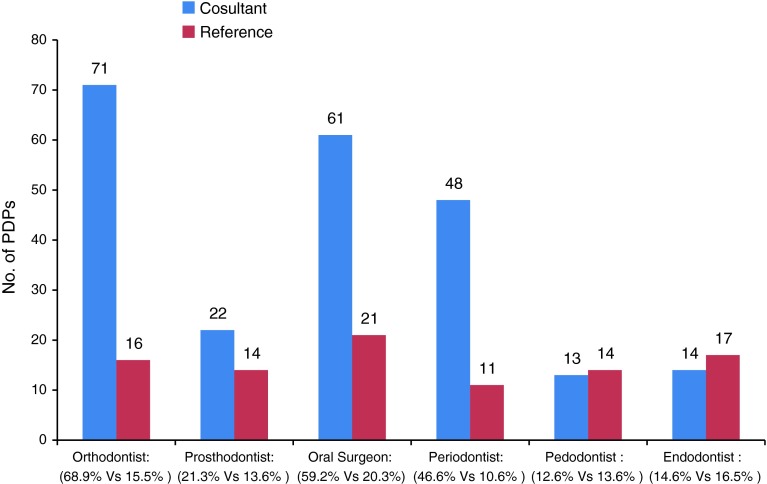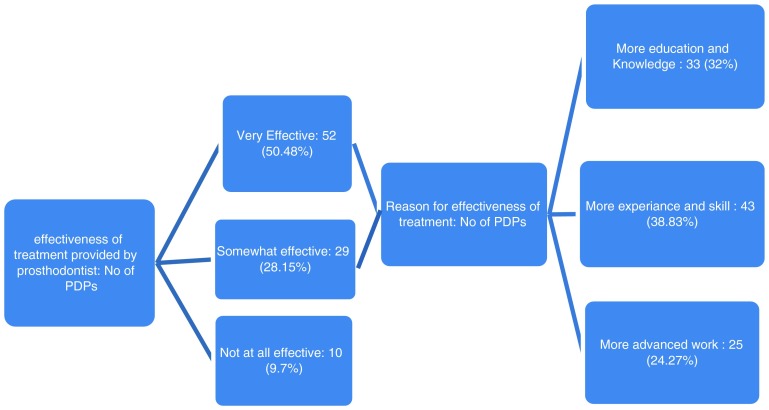Abstract
To identify the perceptions towards and utilization of specialist Prosthodontic services among Private Dental Practitioners (PDPs) of Gujarat state. To study the influence of presence or absence of a Prosthodontic post graduate course during the PDP’s dental education and years of experience in practice on the decisions to treat Prosthodontic cases themselves or to utilise Prosthodontic speciality services. A postal questionnaire examined by a panel of Prosthodontists, piloted on 15 PDPs, was sent to 150 randomly selected private dental practitioners of Gujarat state. The collected data were subjected to descriptive and Chi-square statistical analysis. Though 78.64 % dentists considered the treatment provided by the Prosthodontist to be effective, only 34.95 % of them availed their services. 33 % PDPs without a Prosthodontic post graduate course in their institute were significantly more likely to refer patients to a Prosthodontist. Years of experience had no influence on utilization of Prosthodontic speciality service. 18.44 % PDPs had a Prosthodontic speciality clinic in their region, 65.04 % did not have, whereas 11.65 % were not aware of such clinic. PDPs have high regards for the Prosthodontic speciality but their reported demand was less as compared to other specialities indicating a need for the Prosthodonitst to put in efforts to make the PDPs aware of their services.
Keywords: Prosthodontic speciality service, Private Dental Practitioner, Consultant, Survey, Gujarat
Introduction
Dentistry is essentially a primary care discipline insofar as the vast majority of patient care takes place in the community settings, is restricted to simple procedures and is provided by “generalists” who in the main hold, or aspire to hold, a long-term relationship with their patients [1]. Primary care service providers act as gatekeepers to secondary care service providers [2]. Though specialist services are available in plenty, no local information is available regarding the proportion of PDPs who use this resource or their perceptions of the service quality.
The success of a specialist relies greatly on their colleagues to provide a continual flow of referrals. To be used fully, a specialist needs PDPs to have good referral awareness [3]. (that is, knowing which patients to refer, when to refer and where to refer) [4].
Recent times have seen a change in the trend from referrals to consultant specialist and a decreasing number of mono speciality clinics. Prosthodontics involves a large spectrum of treatment options and patients requiring such treatment form a major part of the general practice. The goal of this survey was to:
Investigate the demand for Prosthodontic services.
Explore PDPs’ perception of Prosthodontist’s work.
Understand the changing trends in private practice.
Determine the influence of presence or absence of a Prosthodontic post graduate program during PDPs dental education on their decisions in practice to treat Prosthodontic cases themselves or utilise the Prosthodontic speciality services.
Materials and Methods
Postal questionnaires were sent to 150 private dental practitioners of Gujarat state. PDPs were randomly selected from Gujarat State Dental Directory-2012, 7th edition. These PDPs were from five regions of the state: Central, South, North, Saurashtra and Kutch region.
The questionnaire was of a closed response format and was piloted on 15 PDPs (Table 1). Minor modifications to the question style were made to ensure the questionnaire was clear to understand and easy to complete. It was then sent to 150 PDPs in reply paid envelopes along with a consent letter to be signed by the PDP. Anonymity of the respondents was assured. There was also an option for the subjects not wishing to fill the questionnaire. Prosthodontists were not included in this survey.
Table 1.
Questionnaire

|
Questions covered general information such as gender, qualification and year of graduation/post graduation. Questionnaire went on to elicit the PDPs’ preference in managing difficult cases, either by calling consultants, referring patients to specialists or doing all work themselves. Questions further investigated if they utilised the services of consultant Prosthodontist or referred patients to a Prosthodontist. A correlation, if any, between the PDPs availing Prosthodontic services and the presence or absence of a Prosthodontic post graduation course during their dental education was tried to be found using the Chi-square test.
Questionnaire went on to assess PDPs’ perception of the effectiveness of the treatment provided by a Prosthodontist and the reasons for the same. Finally, PDPs were questioned if they were aware of any exclusive Prosthodontic clinics in their city/town.
All valid questionnaires were entered in Statistical Package for the Social Sciences (SPSS) version number 12 by a single operator. Descriptive analysis and Chi-square test were carried out.
Results
The overall response rate was 68.66 % (n = 103). Out of 150 questionnaire sent, 47 were not returned leaving 103 useable questionnaires for analysis.
The final sample to be analysed comprised of replies from 80.58 % males and 19.42 % females. Respondents had working experience over a wide range of years and included 80.58 % graduate PDPs and 19.42 % post graduate PDPs (Table 2).
Table 2.
Demographic data
| Gender | |
| Male | 83 |
| Female | 20 |
| Years since graduation/post-graduation | |
| 0–5 years | 41 |
| 6–11 years | 46 |
| 12–17 years | 9 |
| 18–23 years | 5 |
| 24–29 years | 0 |
| 30–35 years | 0 |
| 36–41 years | 1 |
| 44–47 years | 1 |
| Qualification of private dental practitioner | |
| BDS: 83 | 67-Male |
| 16-Female | |
| MDS: 20 | 16-Male |
| 4-Female | |
| Location of private dental clinics | |
| Central Gujarat | 50 |
| North Gujarat | 16 |
| South Gujarat | 13 |
| Saurashtra | 14 |
| Kutch | 10 |
To assess how (i.e. consultants or referrals) and which speciality services were utilised, PDPs were enquired about the management of difficult cases in their practice. When analysed as a whole 76.69 % PDPs preferred to call consultant and 42.72 % PDPs referred patients to specialists. 14.56 % availed none of the speciality service and did all work themselves (Fig. 1). Orthodontists were the most frequently called consultant with 68.93 % PDPs availing their service and Prosthodontists being called by only 21.36 % PDPs. Oral surgeon received referrals from 20.39 % PDPs whereas Prosthodontists received referrals from 13.59 % PDPs (Fig. 2).
Fig. 1.
Type of Practice (Consultant/referral/self)
Fig. 2.
No. of PDPs availing service of specialists: consultant versus reference
PDPs were asked to rate the effectiveness of the treatment provided by a Prosthodontist. Out of 103 PDPs, 50.46 % PDPs considered the treatment provided to be very effective with 28.16 % rating it to be somewhat effective and 9.70 % considering it to be totally ineffective. 41.75 % PDPs stated that the reason for the effectiveness of the treatment provided by Prosthodontist was their experience and skill, 32.03 % believing the reason to be higher education and knowledge and 24.27 % considering it to be the advanced work done by the Prosthodontist (Fig. 3).
Fig. 3.
Effectiveness of treatment provided by Prosthodontists
When the data were subjected to Chi-square test, it showed that the 65.04 % PDPs who had a Prosthodontic post-graduate course during their dental education did not significantly utilize Prosthodontic services (consultant or referral). The results also indicated that 33 % PDPs who did not have a Prosthodontic post graduation course during their dental education significantly utilized Prosthodontic service by referring patient to a Prosthodontist (Fig. 4).
Fig. 4.
Correlation between Prosthodontic PG course during study and utilizing Prosthodontic specialty service
Similarly when the data were subjected to Chi-square test to bring out the relation between the years of practice and utilization of Prosthodontic speciality service (consultant and reference), it was found that the experience in practice did not significantly influence utilization of these services (Table 3).
Table 3.
Years of practice versus utilization of Prosthodontic speciality service
| Years of practice: number of PDPs | Number of PDPs utilizing Prosthodontic service (consultant and reference) | Number of PDPs not utilizing Prosthodontic service | P value |
|---|---|---|---|
| 0–5 years: 41 | A: 7 (17.1 %) | 34 (82.9 %) | <0.0001 |
| B: 4 (9.8 %) | 37 (90.2 %) | <0.0001 | |
| 6–11 years: 46 | A: 13 (28.3 %) | 33 (71.7 %) | 0.003 |
| B: 7 (15.2 %) | 39 (84.8 %) | <0.0001 | |
| 12–17 years: 9 | A: 1 (11.1 %) | 8 (88.9 %) | 0.020 |
| B: 2 (22.2 %) | 7 (77.8 %) | 0.096 | |
| 18–23 years: 5 | A: 1 (20 %) | 4 (80 %) | 0.180 |
| B: 1 (20 %) | 4 (80 %) | 0.180 | |
| 24–29 years: 0 | A: 0 | 0 | NP |
| B: 0 | 0 | NP | |
| 30–35 years: 0 | A: 0 | 0 | NP |
| B: 0 | 0 | NP | |
| 36–41 years: 1 | A: 0 | 1 (100 %) | 0.317 |
| B: 0 | 1 (100 %) | 0.317 | |
| 42–47 years: 1 | A: 0 | 1 (100 %) | 0.317 |
| B: 0 | 1 (100 %) | 0.317 | |
| 48–53 years: 0 | A: 0 | 0 | NP |
| B: 0 | 0 | NP |
A number of PDPs calling consultant Prosthodontists, B number of PDPs referring patients to Prosthodontists
18.44 % PDPs had an exclusive Prosthodontic clinic in their region, 65.04 % did not have such clinic in their region whereas 11.65 % were not aware of such a clinic.
After the consultation with the statistician it was decided that descriptive analysis was the most informative and a statistical test was indicated to bring out the correlation between the presence or absence of Prosthodontic post graduate course and years of experience with the utilization of Prosthodontic services.
Discussion
In a study of variety of questionnaires sent to PDPs, Tan and Burke found that if the overall return rate was 61.7 % then the study addressed key issues [5]. In this study of PDPs of Gujarat state a response rate of 68.66 % was achieved.
Participants represented five regions of Gujarat State and were all private dental practitioners in their early to later practice years. From the data collected, it was seen that even the post graduate dental practitioners were into general dental practice rather than having solely speciality practice. This is possibly due to the increasing number of visiting consultants in every clinic, decreasing the number of referrals to speciality clinics.
In terms of current speciality service patterns, a large proportion of PDPs (76.69 %) preferred consultants visiting their office rather than referring patients to specialists (42.72 %). This is possibly due to the decreasing number of speciality clinics and fear that patients sent to a specialist would never return to the referring dentist [6]. Care would have to be exercised by specialist practitioners to ensure that the patients are sent back to the referring PDP at the conclusion of the specialist treatment. Although, collectively, these findings clearly indicate a high demand for specialists. It is important to recognise that speciality service pattern responses were likely to be estimates rather than accurate records.
When asked about the various speciality services utilised by PDPs (either consultants/referrals), the most common answer was Orthodontia, the second was Oral surgery followed by Periodontia. Prosthodontic services were utilised by only 34.95 % PDPs. Similar observation, of less demand for Prosthodontic service, was noted in the survey of demand for specialist restorative dental services by Nixon and Benson [7]. In another survey of self-perceived educational needs of general dental practitioner in the Merseyside region, it was concluded that the respondents had a high self-perceived knowledge of Prosthodontics [8]. Less demand for Prosthodontic speciality reflects that PDPs are more comfortable carrying out Prosthetic Dentistry as this reflects their skill base. This might also indicate the lack of awareness of Prosthodontic work, other than the basic, which can be carried out at the private practice level.
PDPs who had Prosthodontic post graduate course in the institute during their dental education did not significantly utilise Prosthodontic services and the ones who did not have a similar course were significantly more likely to refer their patients to a Prosthodontist. This may be explained by the fact that the presence of a Prosthodontic post graduate course gave the opportunity to the students to interact with Prosthodontic residents and additional post graduate faculty.
Years of experience did not significantly affect the utilization of Prosthodontic speciality service in our study. This can be due to various factors such as basic prosthodontic practice by a PDP, additional prosthodontic skills acquired by a PDP through CDE programmes, economic factors and so on.
When asked about the effectiveness of the treatment provided by a Prosthodontist and the reasons for the same, most of the PDPs perceived the treatment to be effective with the main reason suggested being their higher experience and skill. This observation of high regard for the focused skill of the Prosthodontist but, the less utilisation of their services indicates a need for the Prosthodontist to bridge this gap and inform PDPs of the services provided by them.
When the PDPs were enquired about the presence of any exclusive speciality Prosthodontic clinic in their city/town, 65.05 % PDPs replied that there were no such clinics. This needs to be further investigated to know whether such speciality clinics exists or PDPs are not aware of them. It has also been suggested that distance from the specialist may be a factor [9], dentists close to a specialist centre being more likely to refer. Whether this is entirely a practitioner factor or one modified by patients’ factor is unclear.
Conclusion
From the results it would seem that there is a strong demand for specialist services, which may increase in the future due to the increasing pressure on PDPs to seek a specialist opinion. The questionnaire indicated a high regard for Prosthodontist suggesting that they are already well respected within the profession though their services are not fully utilised. This study indicates the need for the Prosthodontist to take extra effort to spread their services far and wide. Continuing dental education programs might help to improve the scenario. Changing trends of speciality services from referrals to visiting consultants were noted. As this survey was conducted in a limited group of people, with limited amount of information extracted, further surveys are needed to know the level of Prosthetic work done by PDPs, influence of economic factors, availability of Prosthodontists and so on.
Acknowledgments
We are thankful to Gujarat Prosthodontic Forum for providing us guidance and support.
References
- 1.Morris J, White D, Bradnock G. Primary dental care : time to revise the definition? Prim Dent Care. 2000;7:93–96. doi: 10.1308/135576100322694150. [DOI] [PubMed] [Google Scholar]
- 2.Morris AJ, Burke FJ. Primary and secondary dental care: how ideal is the interface? Br Dent J. 2001;191:666–670. doi: 10.1038/sj.bdj.4801263. [DOI] [PubMed] [Google Scholar]
- 3.Woodman AJ. Who wants to be a specialist? Br Dent J. 1998;184:312. doi: 10.1038/sj.bdj.4809610. [DOI] [PubMed] [Google Scholar]
- 4.Basker RM, Harrison A, Ralph JP. A survey of patients referred to restorative dentistry clinics. Br Dent J. 1988;164:105–108. doi: 10.1038/sj.bdj.4806372. [DOI] [PubMed] [Google Scholar]
- 5.Tan RT, Burke FJ. Response rates to questionnaires mailed to dentists. A review of 77 publications. Int Dent J. 1997;47:349–354. doi: 10.1111/j.1875-595X.1997.tb00460.x. [DOI] [Google Scholar]
- 6.Fairbrother KJ, Nohl FS. Perceptions of general dental practitioners of a local secondary care service in restorative dentistry. Br Dent J. 2000;188:99–102. doi: 10.1038/sj.bdj.4800400. [DOI] [PubMed] [Google Scholar]
- 7.Nixon PJ, Benson RE. A survey of demand for specialist restorative dental services. Br Dent J. 2005;199:161–163. doi: 10.1038/sj.bdj.4812577. [DOI] [PubMed] [Google Scholar]
- 8.Sutton F, Ellituv ZN, Seed R. A survey of self-perceived educational needs of general dental practitioners in the Merseyside region. Prim Dent Care. 2005;12:78–82. doi: 10.1308/1355761054348468. [DOI] [PubMed] [Google Scholar]
- 9.Linden GJ, Stevenson M, Burke FJ. Variation in periodontal referral in two regions in the UK. J Clin Periodontal. 1999;26:590–595. doi: 10.1034/j.1600-051X.1999.260905.x. [DOI] [PubMed] [Google Scholar]






